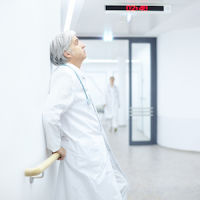Automating symptoms recording clerical aspects of medical record keeping through speech recognition during a patient’s visit1 could allow physicians to dedicate more time directly with patients, according to a new report published in JAMA Intern Med.
Researchers considered the feasibility of using machine learning to automatically populate a review of systems (ROS) of all symptoms discussed in an encounter.
Methods
For the report, researchers used 90,000 human-transcribed, de-identified medical encounters described previously2. The 2547 subjects were then randomly collected from primary care and selected medical subspecialties to undergo labelling of 185symptoms by scribes. The rest were used for unsupervised training of the research model, a recurrent neural network3,4 that has been commonly used for language understanding. There were previously reported model details5.
Because some mentions of symptoms were irrelevant to the ROS (eg, a physician mentioning “nausea” as a possible adverse effect), scribes assigned each symptom mention a relevance to the ROS, defined as being directly related to a patient's experience. Scribes also indicated if the symptom was experienced or not. A total of 2547 labeled transcripts were randomly split into training (2091 [80%]) and test (456 [20%]) sets.
From the test set, researchers then selected 800 snippets containing at least 1 of 16 common symptoms that would be included in the ROS, and asked 2 scribes to independently assess how likely they would include the initially labeled symptom in the ROS. When both said “extremely likely” we defined this as a “clearly mentioned” symptom. All other symptom mentions were considered “unclear.”
The input to the machine learning model used in the report, was a sliding window of 5 conversation turns (snippets), and its output was each symptom mentioned, its relevance, and if the patient experienced it. Then the team assessed the sensitivity and positive-predictive value, across the entire test set. They additionally calculated the sensitivity of identifying the symptom and the accuracy of correct documentation, in clearly vs unclearly mentioned symptoms.
The study was exempt from institutional review board approval because of the retrospective de-identified nature of the data set and the snippets presented in the manuscript are synthetic snippets modelled after real spoken language patterns, but are not from the original dataset and contain no data derived from actual patients.
Results
In the test set, there were 5970 symptom mentions. Of these 5970, 4730 (79.3%) were relevant to the ROS and 3510 (74.2%) were experienced.
Across the full test set, the sensitivity of the model to identify symptoms was 67.7% (5172/7637) and the positive predictive value of a predicted symptom was 80.6% (5172/6417). Researchers presented examples of snippets and model predictions in the report.
From human review of the 800 snippets, slightly less than half of symptom mentions were clear (387/800 [48.4%]), with fair agreement between raters on the likelihood to include a symptom as initially labeled in the ROS (κ = 0.32, P < .001). For clearly mentioned symptoms the sensitivity of the model was 92.2% (357/387). For unclear ones, it was 67.8% (280/413).
The model would accurately document—meaning correct identification of a symptom, correct classification of relevance to the note, and assignment of experienced or not—in 87.9% (340/387) of symptoms mentioned clearly and 60.0% (248/413) in ones mentioned unclearly.
Discussion
Previous discussions of auto-charting take for granted that the same technologies that work on our smartphones will work in clinical practice. By going through the process of adapting such technology to a simple ROS auto-charting task, researchers reported a key challenge not previously considered: a substantial proportion of symptoms were mentioned vaguely, such that even human scribes do not agree on how to adequately document them. Encouragingly, the model performed well on clearly mentioned symptoms, but its performance dropped significantly on unclearly mentioned ones. Solving this problem will require precise, though not necessarily jargon heavy, communication, reported the researchers. Further research will be needed to assist clinicians with more meaningful tasks such as documenting the history of present illness.
Conflict of Interest Disclosures:
All authors are employed by and own stock in Google. In addition, as part of a broad-based equity portfolio intending to mirror the US and International equities markets (eg, MSCI All Country World, Russell 3000), Jeff Dean holds individual stock positions in many public companies in the health care and pharmacological sectors, and also has investments in managed funds that also invest in such companies, as well as limited partner and direct venture investments in private companies operating in these sectors. All other health care–related investments are managed by independent third parties (institutional managers) with whom Jeff Dean has no direct contact and over whom Jeff Dean has no control. The authors have a patent pending for the machine learning tool described in this study. No other conflicts are reported.
Additional Contributions:
Kathryn Rough, PhD, and Mila Hardt, PhD, for helpful discussions on the manuscript; Mike Pearson, MBA, Ken Su, MBA, MBH, and Kasumi Widner, MS, for data collection; Diana Jaunzeikare, BA, Chris Co, PhD, Daniel Tse, MD, and Nina Gonzalez, MD, for labeling; Linh Tran, PhD, Nan Du, PhD, Yu-hui Chen, PhD, Yonghui Wu, PhD, Kyle Scholz, BS, Izhak Shafran, PhD, Patrick Nguyen, PhD, Chung-cheng Chiu, PhD, Zhifeng Chen, PhD, for helpful discussions on modeling; and Rebecca Rolfe, MSc, for illustrations. All individuals work at Google. They were not compensated outside of their normal duties for their contributions.
Source: JAMA Intern Med.
Image Credit: iStock
References:
1.
Verghese A, Shah NH, Harrington RA. What this computer needs is a physician: humanism and artificial intelligence. JAMA. 2018;319(1):19-20. doi:10.1001/jama.2017.19198ArticlePubMedGoogle ScholarCrossref
2.
Chiu C-C, Tripathi A, Chou K, et al. Speech Recognition for Medical Conversations. In: Interspeech 2018. ISCA: ISCA; 2018. https://www.isca-speech.org/archive/Interspeech_2018/abstracts/0040.html. Accessed December 8, 2018.
3.
Sutskever I, Vinyals O, Le QV. Sequence to Sequence Learning with Neural Networks. In: Ghahramani Z, Welling M, Cortes C, Lawrence ND, Weinberger KQ, eds. Advances in Neural Information Processing Systems. vol 27. 2014.http://papers.nips.cc/paper/5346-sequence-to-sequence-learning-with-neural-networks.pdf. Accessed December 8, 2018.
4.
Cho K, van Merriënboer B, Gülçehre Ç, et al. Learning Phrase Representations using RNN Encoder–Decoder for Statistical Machine Translation. In: Proceedings of the 2014 Conference on Empirical Methods in Natural Language Processing (EMNLP). Doha, Qatar: Association for Computational Linguistics; 2014:1724-1734.
5.
Kannan A, Chen K, Jaunzeikare D, Rajkomar A. Semi-supervised Learning for Information Extraction from Dialogue. In: Interspeech 2018. ISCA: ISCA; 2018. https://www.isca-speech.org/archive/Interspeech_2018/abstracts/1318.html. Accessed December 8, 2018.
Latest Articles
Imaging, physicians, patient care, Quality of Care, quality improvement, speech recognition, machine learning, 42nd Annual Scientific Meeting of Society of Interventional Radiology, deep learning, datasets, symptoms recording, ROS, positive-predictive value
Automating symptoms recording clerical aspects of medical record keeping through speech recognition during a patient’s visit1 could allow physicians to dedicate more time directly with patients, according to a new report published in JAMA Intern Med. Res



























